International Human Rights Law
VerifiedAdded on 2022/12/01
|12
|3643
|481
AI Summary
This report explores the concept of International Human Rights Law and compares the effectiveness of the UN Charter-based mechanism and the UN Treaty-based system for human rights protection. It discusses the characteristics of human rights, the international law on human rights, the history of human rights, and the international supervisory mechanisms for human rights. The report concludes with a comparison between the Charter-based and Treaty-based systems.
Contribute Materials
Your contribution can guide someone’s learning journey. Share your
documents today.
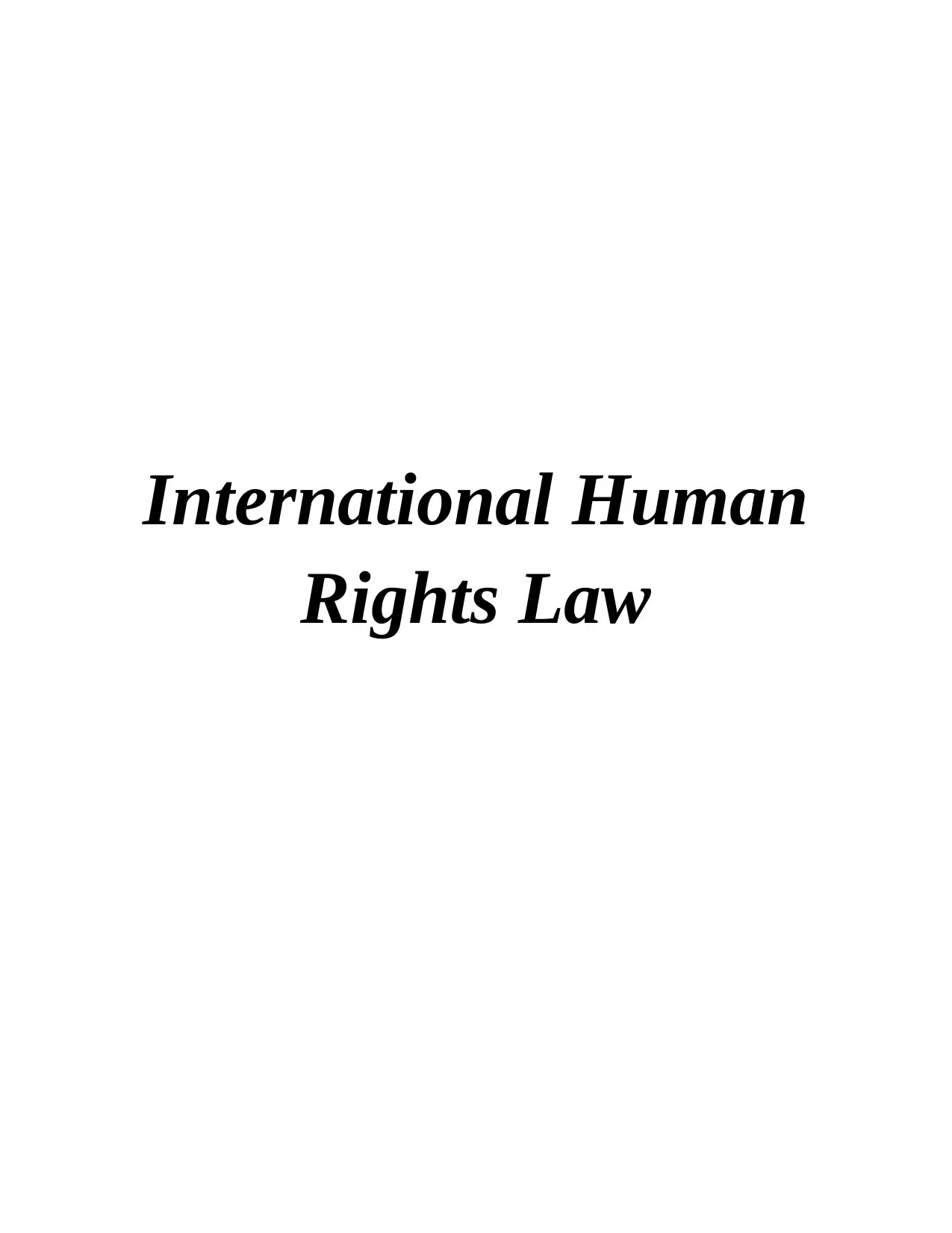
International Human
Rights Law
Rights Law
Secure Best Marks with AI Grader
Need help grading? Try our AI Grader for instant feedback on your assignments.
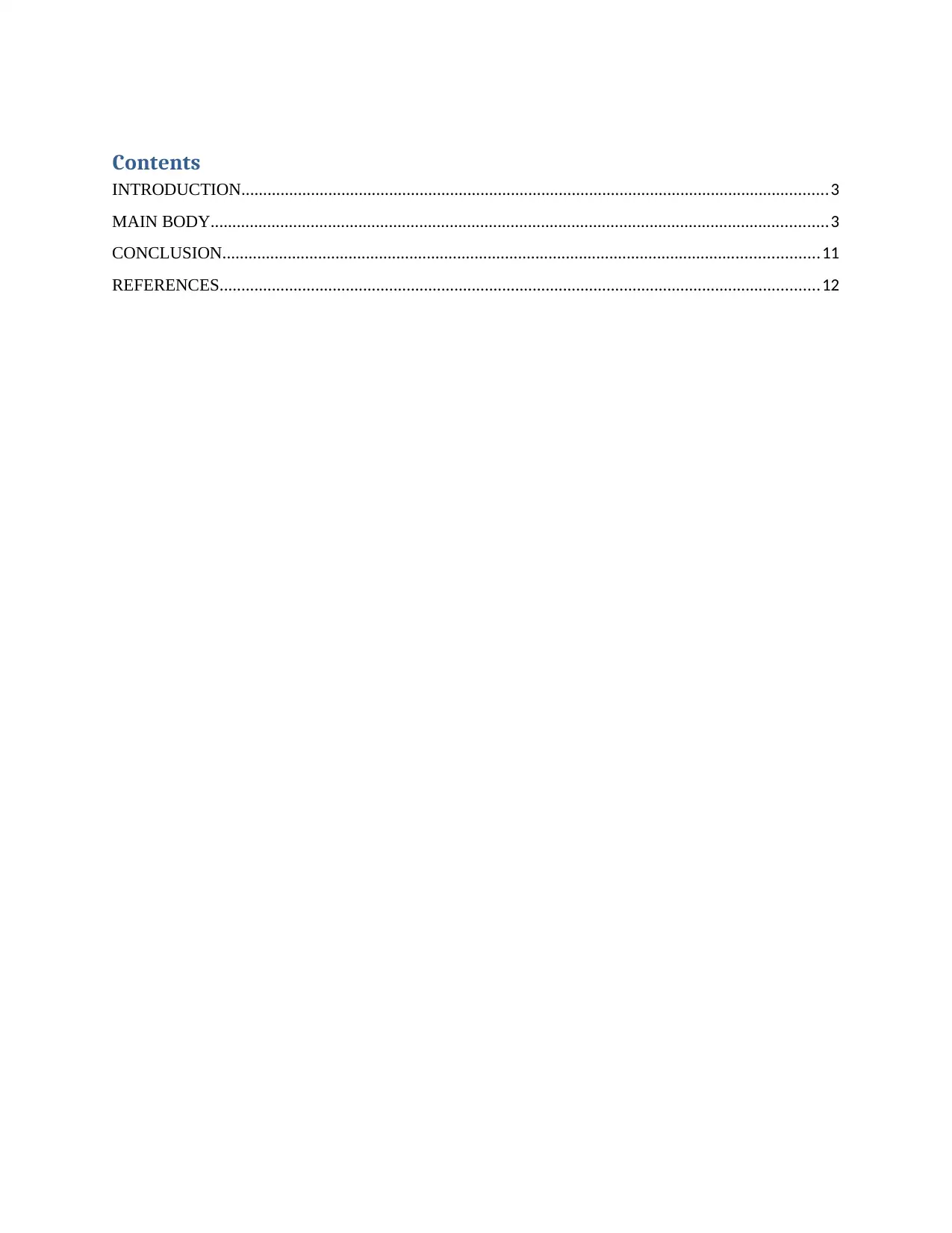
Contents
INTRODUCTION.......................................................................................................................................3
MAIN BODY..............................................................................................................................................3
CONCLUSION.........................................................................................................................................11
REFERENCES..........................................................................................................................................12
INTRODUCTION.......................................................................................................................................3
MAIN BODY..............................................................................................................................................3
CONCLUSION.........................................................................................................................................11
REFERENCES..........................................................................................................................................12
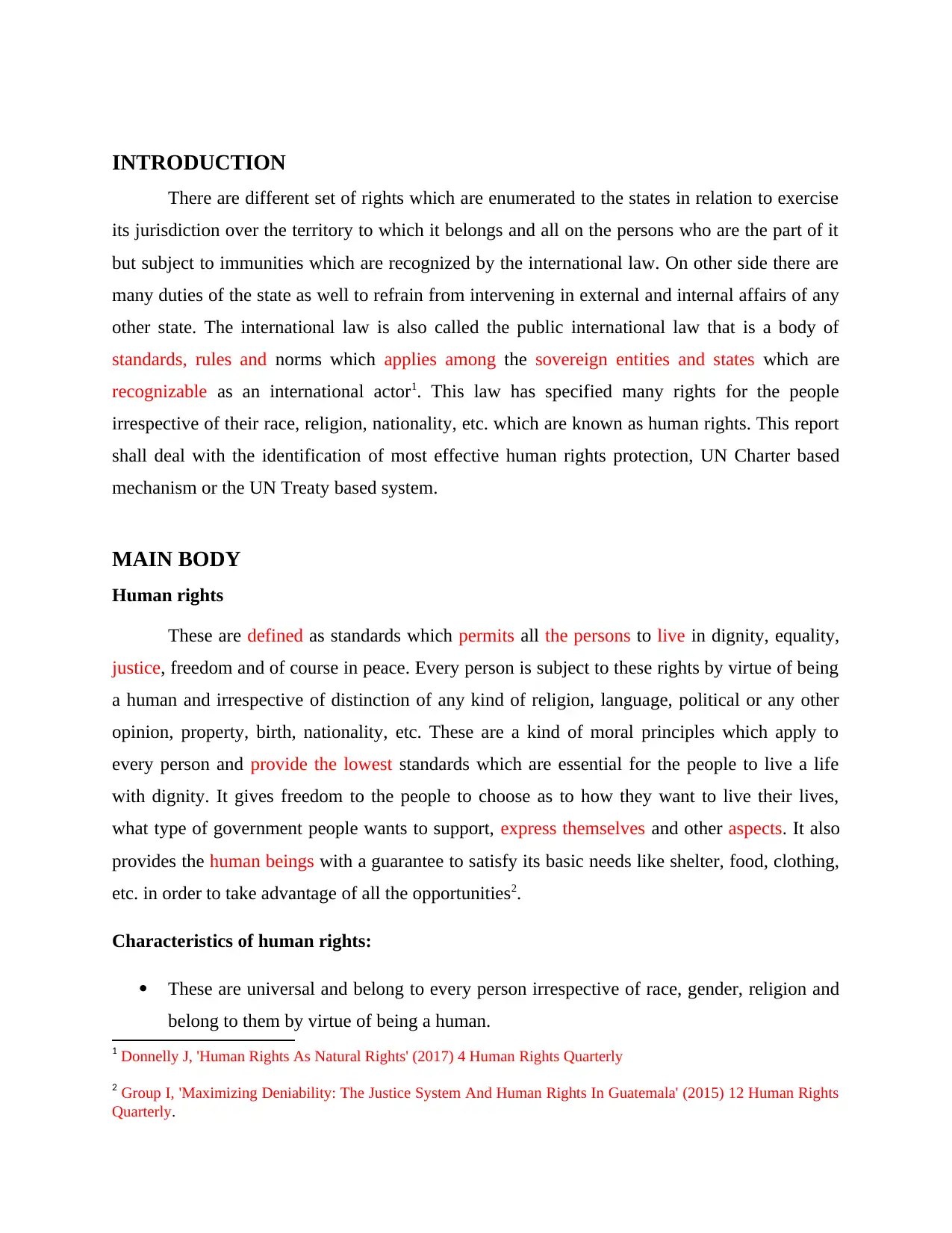
INTRODUCTION
There are different set of rights which are enumerated to the states in relation to exercise
its jurisdiction over the territory to which it belongs and all on the persons who are the part of it
but subject to immunities which are recognized by the international law. On other side there are
many duties of the state as well to refrain from intervening in external and internal affairs of any
other state. The international law is also called the public international law that is a body of
standards, rules and norms which applies among the sovereign entities and states which are
recognizable as an international actor1. This law has specified many rights for the people
irrespective of their race, religion, nationality, etc. which are known as human rights. This report
shall deal with the identification of most effective human rights protection, UN Charter based
mechanism or the UN Treaty based system.
MAIN BODY
Human rights
These are defined as standards which permits all the persons to live in dignity, equality,
justice, freedom and of course in peace. Every person is subject to these rights by virtue of being
a human and irrespective of distinction of any kind of religion, language, political or any other
opinion, property, birth, nationality, etc. These are a kind of moral principles which apply to
every person and provide the lowest standards which are essential for the people to live a life
with dignity. It gives freedom to the people to choose as to how they want to live their lives,
what type of government people wants to support, express themselves and other aspects. It also
provides the human beings with a guarantee to satisfy its basic needs like shelter, food, clothing,
etc. in order to take advantage of all the opportunities2.
Characteristics of human rights:
These are universal and belong to every person irrespective of race, gender, religion and
belong to them by virtue of being a human.
1 Donnelly J, 'Human Rights As Natural Rights' (2017) 4 Human Rights Quarterly
2 Group I, 'Maximizing Deniability: The Justice System And Human Rights In Guatemala' (2015) 12 Human Rights
Quarterly.
There are different set of rights which are enumerated to the states in relation to exercise
its jurisdiction over the territory to which it belongs and all on the persons who are the part of it
but subject to immunities which are recognized by the international law. On other side there are
many duties of the state as well to refrain from intervening in external and internal affairs of any
other state. The international law is also called the public international law that is a body of
standards, rules and norms which applies among the sovereign entities and states which are
recognizable as an international actor1. This law has specified many rights for the people
irrespective of their race, religion, nationality, etc. which are known as human rights. This report
shall deal with the identification of most effective human rights protection, UN Charter based
mechanism or the UN Treaty based system.
MAIN BODY
Human rights
These are defined as standards which permits all the persons to live in dignity, equality,
justice, freedom and of course in peace. Every person is subject to these rights by virtue of being
a human and irrespective of distinction of any kind of religion, language, political or any other
opinion, property, birth, nationality, etc. These are a kind of moral principles which apply to
every person and provide the lowest standards which are essential for the people to live a life
with dignity. It gives freedom to the people to choose as to how they want to live their lives,
what type of government people wants to support, express themselves and other aspects. It also
provides the human beings with a guarantee to satisfy its basic needs like shelter, food, clothing,
etc. in order to take advantage of all the opportunities2.
Characteristics of human rights:
These are universal and belong to every person irrespective of race, gender, religion and
belong to them by virtue of being a human.
1 Donnelly J, 'Human Rights As Natural Rights' (2017) 4 Human Rights Quarterly
2 Group I, 'Maximizing Deniability: The Justice System And Human Rights In Guatemala' (2015) 12 Human Rights
Quarterly.
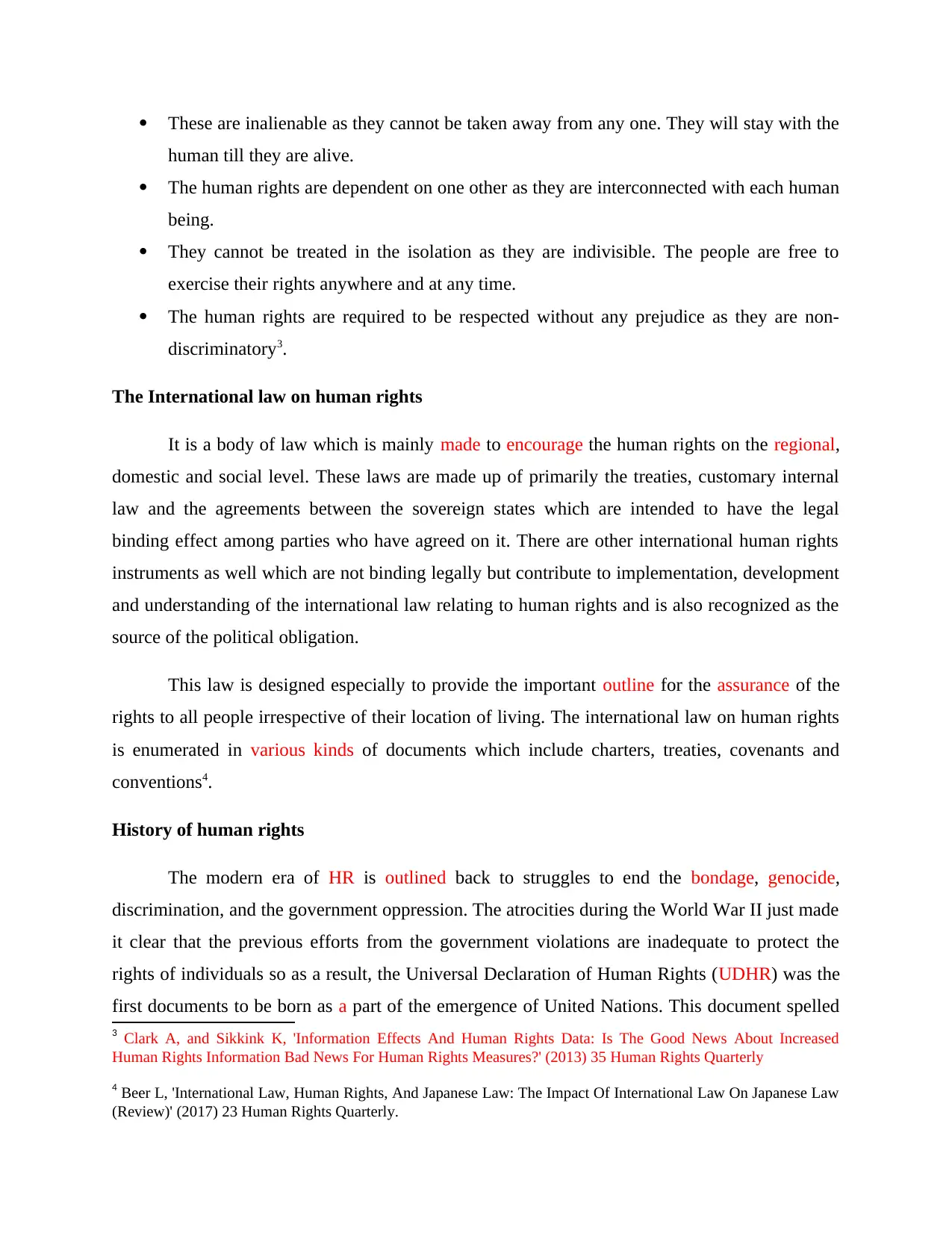
These are inalienable as they cannot be taken away from any one. They will stay with the
human till they are alive.
The human rights are dependent on one other as they are interconnected with each human
being.
They cannot be treated in the isolation as they are indivisible. The people are free to
exercise their rights anywhere and at any time.
The human rights are required to be respected without any prejudice as they are non-
discriminatory3.
The International law on human rights
It is a body of law which is mainly made to encourage the human rights on the regional,
domestic and social level. These laws are made up of primarily the treaties, customary internal
law and the agreements between the sovereign states which are intended to have the legal
binding effect among parties who have agreed on it. There are other international human rights
instruments as well which are not binding legally but contribute to implementation, development
and understanding of the international law relating to human rights and is also recognized as the
source of the political obligation.
This law is designed especially to provide the important outline for the assurance of the
rights to all people irrespective of their location of living. The international law on human rights
is enumerated in various kinds of documents which include charters, treaties, covenants and
conventions4.
History of human rights
The modern era of HR is outlined back to struggles to end the bondage, genocide,
discrimination, and the government oppression. The atrocities during the World War II just made
it clear that the previous efforts from the government violations are inadequate to protect the
rights of individuals so as a result, the Universal Declaration of Human Rights (UDHR) was the
first documents to be born as a part of the emergence of United Nations. This document spelled
3 Clark A, and Sikkink K, 'Information Effects And Human Rights Data: Is The Good News About Increased
Human Rights Information Bad News For Human Rights Measures?' (2013) 35 Human Rights Quarterly
4 Beer L, 'International Law, Human Rights, And Japanese Law: The Impact Of International Law On Japanese Law
(Review)' (2017) 23 Human Rights Quarterly.
human till they are alive.
The human rights are dependent on one other as they are interconnected with each human
being.
They cannot be treated in the isolation as they are indivisible. The people are free to
exercise their rights anywhere and at any time.
The human rights are required to be respected without any prejudice as they are non-
discriminatory3.
The International law on human rights
It is a body of law which is mainly made to encourage the human rights on the regional,
domestic and social level. These laws are made up of primarily the treaties, customary internal
law and the agreements between the sovereign states which are intended to have the legal
binding effect among parties who have agreed on it. There are other international human rights
instruments as well which are not binding legally but contribute to implementation, development
and understanding of the international law relating to human rights and is also recognized as the
source of the political obligation.
This law is designed especially to provide the important outline for the assurance of the
rights to all people irrespective of their location of living. The international law on human rights
is enumerated in various kinds of documents which include charters, treaties, covenants and
conventions4.
History of human rights
The modern era of HR is outlined back to struggles to end the bondage, genocide,
discrimination, and the government oppression. The atrocities during the World War II just made
it clear that the previous efforts from the government violations are inadequate to protect the
rights of individuals so as a result, the Universal Declaration of Human Rights (UDHR) was the
first documents to be born as a part of the emergence of United Nations. This document spelled
3 Clark A, and Sikkink K, 'Information Effects And Human Rights Data: Is The Good News About Increased
Human Rights Information Bad News For Human Rights Measures?' (2013) 35 Human Rights Quarterly
4 Beer L, 'International Law, Human Rights, And Japanese Law: The Impact Of International Law On Japanese Law
(Review)' (2017) 23 Human Rights Quarterly.
Secure Best Marks with AI Grader
Need help grading? Try our AI Grader for instant feedback on your assignments.
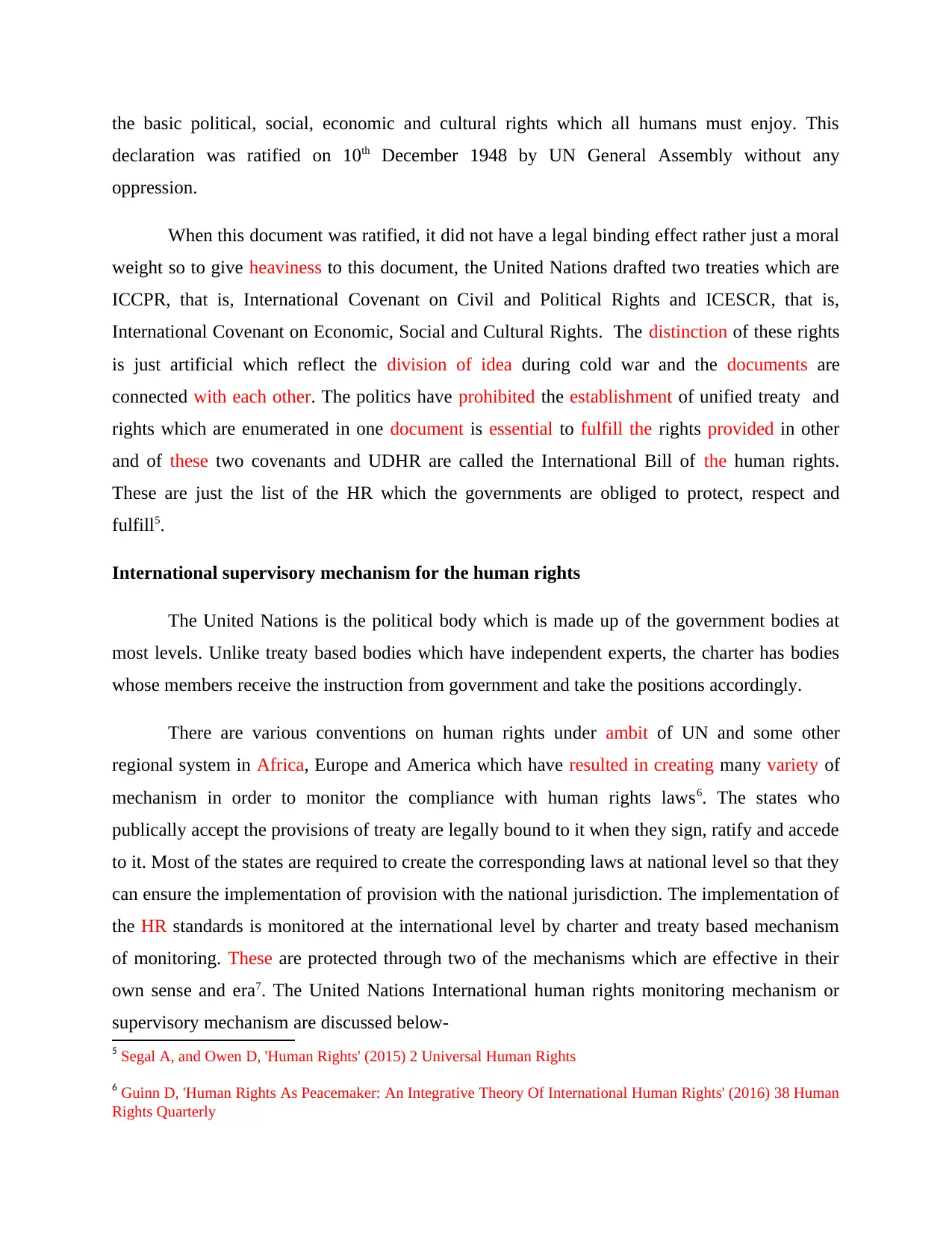
the basic political, social, economic and cultural rights which all humans must enjoy. This
declaration was ratified on 10th December 1948 by UN General Assembly without any
oppression.
When this document was ratified, it did not have a legal binding effect rather just a moral
weight so to give heaviness to this document, the United Nations drafted two treaties which are
ICCPR, that is, International Covenant on Civil and Political Rights and ICESCR, that is,
International Covenant on Economic, Social and Cultural Rights. The distinction of these rights
is just artificial which reflect the division of idea during cold war and the documents are
connected with each other. The politics have prohibited the establishment of unified treaty and
rights which are enumerated in one document is essential to fulfill the rights provided in other
and of these two covenants and UDHR are called the International Bill of the human rights.
These are just the list of the HR which the governments are obliged to protect, respect and
fulfill5.
International supervisory mechanism for the human rights
The United Nations is the political body which is made up of the government bodies at
most levels. Unlike treaty based bodies which have independent experts, the charter has bodies
whose members receive the instruction from government and take the positions accordingly.
There are various conventions on human rights under ambit of UN and some other
regional system in Africa, Europe and America which have resulted in creating many variety of
mechanism in order to monitor the compliance with human rights laws6. The states who
publically accept the provisions of treaty are legally bound to it when they sign, ratify and accede
to it. Most of the states are required to create the corresponding laws at national level so that they
can ensure the implementation of provision with the national jurisdiction. The implementation of
the HR standards is monitored at the international level by charter and treaty based mechanism
of monitoring. These are protected through two of the mechanisms which are effective in their
own sense and era7. The United Nations International human rights monitoring mechanism or
supervisory mechanism are discussed below-
5 Segal A, and Owen D, 'Human Rights' (2015) 2 Universal Human Rights
6 Guinn D, 'Human Rights As Peacemaker: An Integrative Theory Of International Human Rights' (2016) 38 Human
Rights Quarterly
declaration was ratified on 10th December 1948 by UN General Assembly without any
oppression.
When this document was ratified, it did not have a legal binding effect rather just a moral
weight so to give heaviness to this document, the United Nations drafted two treaties which are
ICCPR, that is, International Covenant on Civil and Political Rights and ICESCR, that is,
International Covenant on Economic, Social and Cultural Rights. The distinction of these rights
is just artificial which reflect the division of idea during cold war and the documents are
connected with each other. The politics have prohibited the establishment of unified treaty and
rights which are enumerated in one document is essential to fulfill the rights provided in other
and of these two covenants and UDHR are called the International Bill of the human rights.
These are just the list of the HR which the governments are obliged to protect, respect and
fulfill5.
International supervisory mechanism for the human rights
The United Nations is the political body which is made up of the government bodies at
most levels. Unlike treaty based bodies which have independent experts, the charter has bodies
whose members receive the instruction from government and take the positions accordingly.
There are various conventions on human rights under ambit of UN and some other
regional system in Africa, Europe and America which have resulted in creating many variety of
mechanism in order to monitor the compliance with human rights laws6. The states who
publically accept the provisions of treaty are legally bound to it when they sign, ratify and accede
to it. Most of the states are required to create the corresponding laws at national level so that they
can ensure the implementation of provision with the national jurisdiction. The implementation of
the HR standards is monitored at the international level by charter and treaty based mechanism
of monitoring. These are protected through two of the mechanisms which are effective in their
own sense and era7. The United Nations International human rights monitoring mechanism or
supervisory mechanism are discussed below-
5 Segal A, and Owen D, 'Human Rights' (2015) 2 Universal Human Rights
6 Guinn D, 'Human Rights As Peacemaker: An Integrative Theory Of International Human Rights' (2016) 38 Human
Rights Quarterly
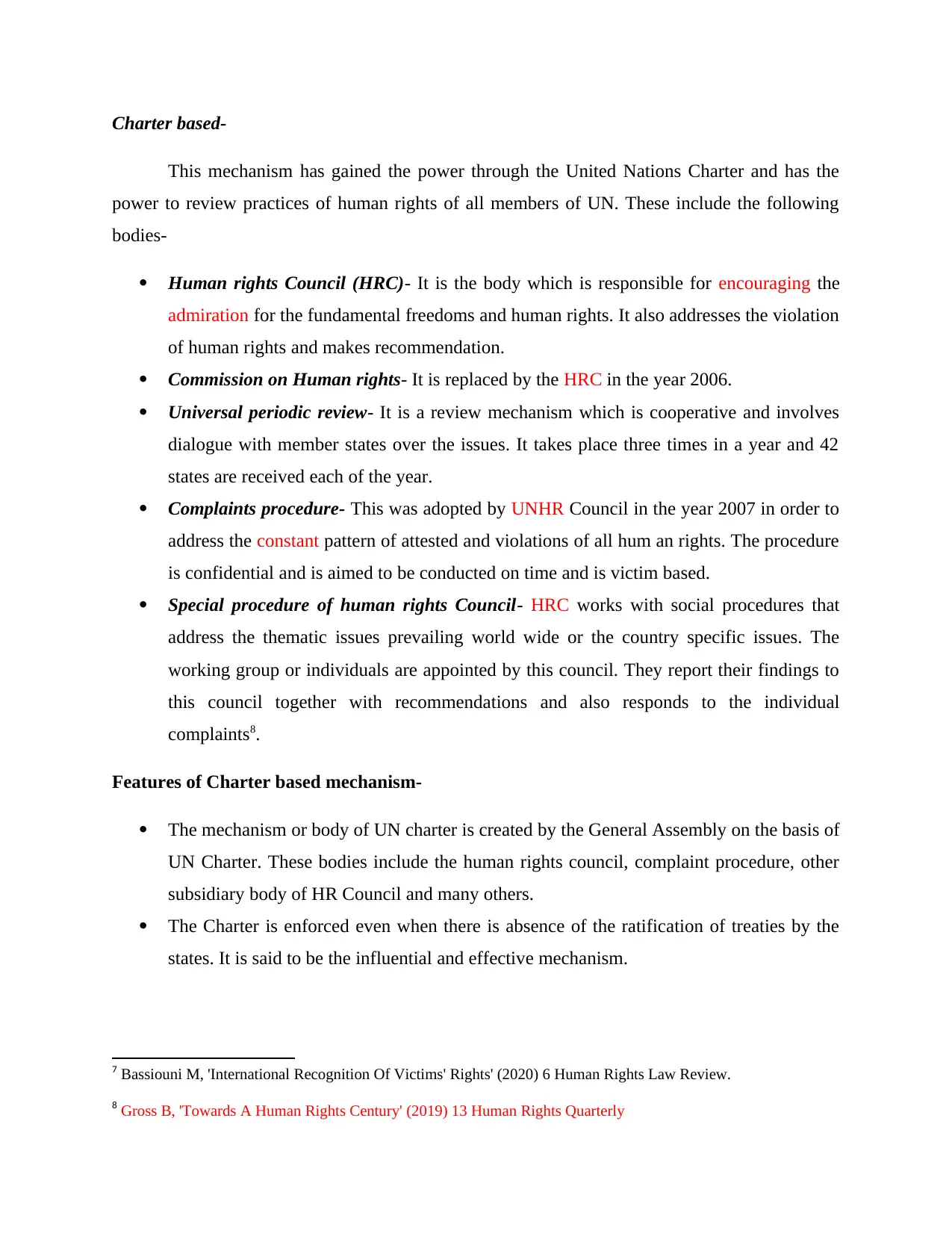
Charter based-
This mechanism has gained the power through the United Nations Charter and has the
power to review practices of human rights of all members of UN. These include the following
bodies-
Human rights Council (HRC)- It is the body which is responsible for encouraging the
admiration for the fundamental freedoms and human rights. It also addresses the violation
of human rights and makes recommendation.
Commission on Human rights- It is replaced by the HRC in the year 2006.
Universal periodic review- It is a review mechanism which is cooperative and involves
dialogue with member states over the issues. It takes place three times in a year and 42
states are received each of the year.
Complaints procedure- This was adopted by UNHR Council in the year 2007 in order to
address the constant pattern of attested and violations of all hum an rights. The procedure
is confidential and is aimed to be conducted on time and is victim based.
Special procedure of human rights Council- HRC works with social procedures that
address the thematic issues prevailing world wide or the country specific issues. The
working group or individuals are appointed by this council. They report their findings to
this council together with recommendations and also responds to the individual
complaints8.
Features of Charter based mechanism-
The mechanism or body of UN charter is created by the General Assembly on the basis of
UN Charter. These bodies include the human rights council, complaint procedure, other
subsidiary body of HR Council and many others.
The Charter is enforced even when there is absence of the ratification of treaties by the
states. It is said to be the influential and effective mechanism.
7 Bassiouni M, 'International Recognition Of Victims' Rights' (2020) 6 Human Rights Law Review.
8 Gross B, 'Towards A Human Rights Century' (2019) 13 Human Rights Quarterly
This mechanism has gained the power through the United Nations Charter and has the
power to review practices of human rights of all members of UN. These include the following
bodies-
Human rights Council (HRC)- It is the body which is responsible for encouraging the
admiration for the fundamental freedoms and human rights. It also addresses the violation
of human rights and makes recommendation.
Commission on Human rights- It is replaced by the HRC in the year 2006.
Universal periodic review- It is a review mechanism which is cooperative and involves
dialogue with member states over the issues. It takes place three times in a year and 42
states are received each of the year.
Complaints procedure- This was adopted by UNHR Council in the year 2007 in order to
address the constant pattern of attested and violations of all hum an rights. The procedure
is confidential and is aimed to be conducted on time and is victim based.
Special procedure of human rights Council- HRC works with social procedures that
address the thematic issues prevailing world wide or the country specific issues. The
working group or individuals are appointed by this council. They report their findings to
this council together with recommendations and also responds to the individual
complaints8.
Features of Charter based mechanism-
The mechanism or body of UN charter is created by the General Assembly on the basis of
UN Charter. These bodies include the human rights council, complaint procedure, other
subsidiary body of HR Council and many others.
The Charter is enforced even when there is absence of the ratification of treaties by the
states. It is said to be the influential and effective mechanism.
7 Bassiouni M, 'International Recognition Of Victims' Rights' (2020) 6 Human Rights Law Review.
8 Gross B, 'Towards A Human Rights Century' (2019) 13 Human Rights Quarterly
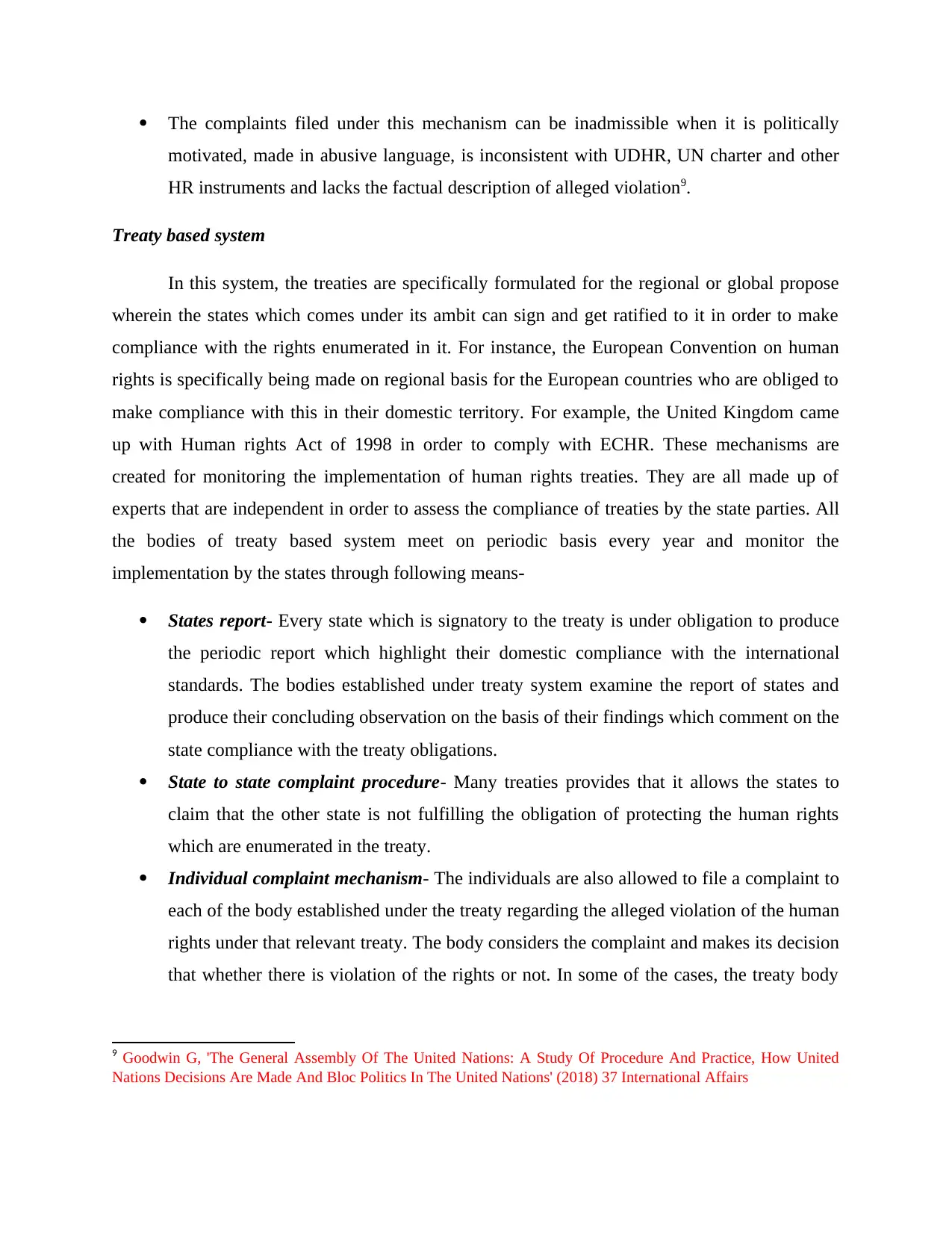
The complaints filed under this mechanism can be inadmissible when it is politically
motivated, made in abusive language, is inconsistent with UDHR, UN charter and other
HR instruments and lacks the factual description of alleged violation9.
Treaty based system
In this system, the treaties are specifically formulated for the regional or global propose
wherein the states which comes under its ambit can sign and get ratified to it in order to make
compliance with the rights enumerated in it. For instance, the European Convention on human
rights is specifically being made on regional basis for the European countries who are obliged to
make compliance with this in their domestic territory. For example, the United Kingdom came
up with Human rights Act of 1998 in order to comply with ECHR. These mechanisms are
created for monitoring the implementation of human rights treaties. They are all made up of
experts that are independent in order to assess the compliance of treaties by the state parties. All
the bodies of treaty based system meet on periodic basis every year and monitor the
implementation by the states through following means-
States report- Every state which is signatory to the treaty is under obligation to produce
the periodic report which highlight their domestic compliance with the international
standards. The bodies established under treaty system examine the report of states and
produce their concluding observation on the basis of their findings which comment on the
state compliance with the treaty obligations.
State to state complaint procedure- Many treaties provides that it allows the states to
claim that the other state is not fulfilling the obligation of protecting the human rights
which are enumerated in the treaty.
Individual complaint mechanism- The individuals are also allowed to file a complaint to
each of the body established under the treaty regarding the alleged violation of the human
rights under that relevant treaty. The body considers the complaint and makes its decision
that whether there is violation of the rights or not. In some of the cases, the treaty body
9 Goodwin G, 'The General Assembly Of The United Nations: A Study Of Procedure And Practice, How United
Nations Decisions Are Made And Bloc Politics In The United Nations' (2018) 37 International Affairs
motivated, made in abusive language, is inconsistent with UDHR, UN charter and other
HR instruments and lacks the factual description of alleged violation9.
Treaty based system
In this system, the treaties are specifically formulated for the regional or global propose
wherein the states which comes under its ambit can sign and get ratified to it in order to make
compliance with the rights enumerated in it. For instance, the European Convention on human
rights is specifically being made on regional basis for the European countries who are obliged to
make compliance with this in their domestic territory. For example, the United Kingdom came
up with Human rights Act of 1998 in order to comply with ECHR. These mechanisms are
created for monitoring the implementation of human rights treaties. They are all made up of
experts that are independent in order to assess the compliance of treaties by the state parties. All
the bodies of treaty based system meet on periodic basis every year and monitor the
implementation by the states through following means-
States report- Every state which is signatory to the treaty is under obligation to produce
the periodic report which highlight their domestic compliance with the international
standards. The bodies established under treaty system examine the report of states and
produce their concluding observation on the basis of their findings which comment on the
state compliance with the treaty obligations.
State to state complaint procedure- Many treaties provides that it allows the states to
claim that the other state is not fulfilling the obligation of protecting the human rights
which are enumerated in the treaty.
Individual complaint mechanism- The individuals are also allowed to file a complaint to
each of the body established under the treaty regarding the alleged violation of the human
rights under that relevant treaty. The body considers the complaint and makes its decision
that whether there is violation of the rights or not. In some of the cases, the treaty body
9 Goodwin G, 'The General Assembly Of The United Nations: A Study Of Procedure And Practice, How United
Nations Decisions Are Made And Bloc Politics In The United Nations' (2018) 37 International Affairs
Paraphrase This Document
Need a fresh take? Get an instant paraphrase of this document with our AI Paraphraser
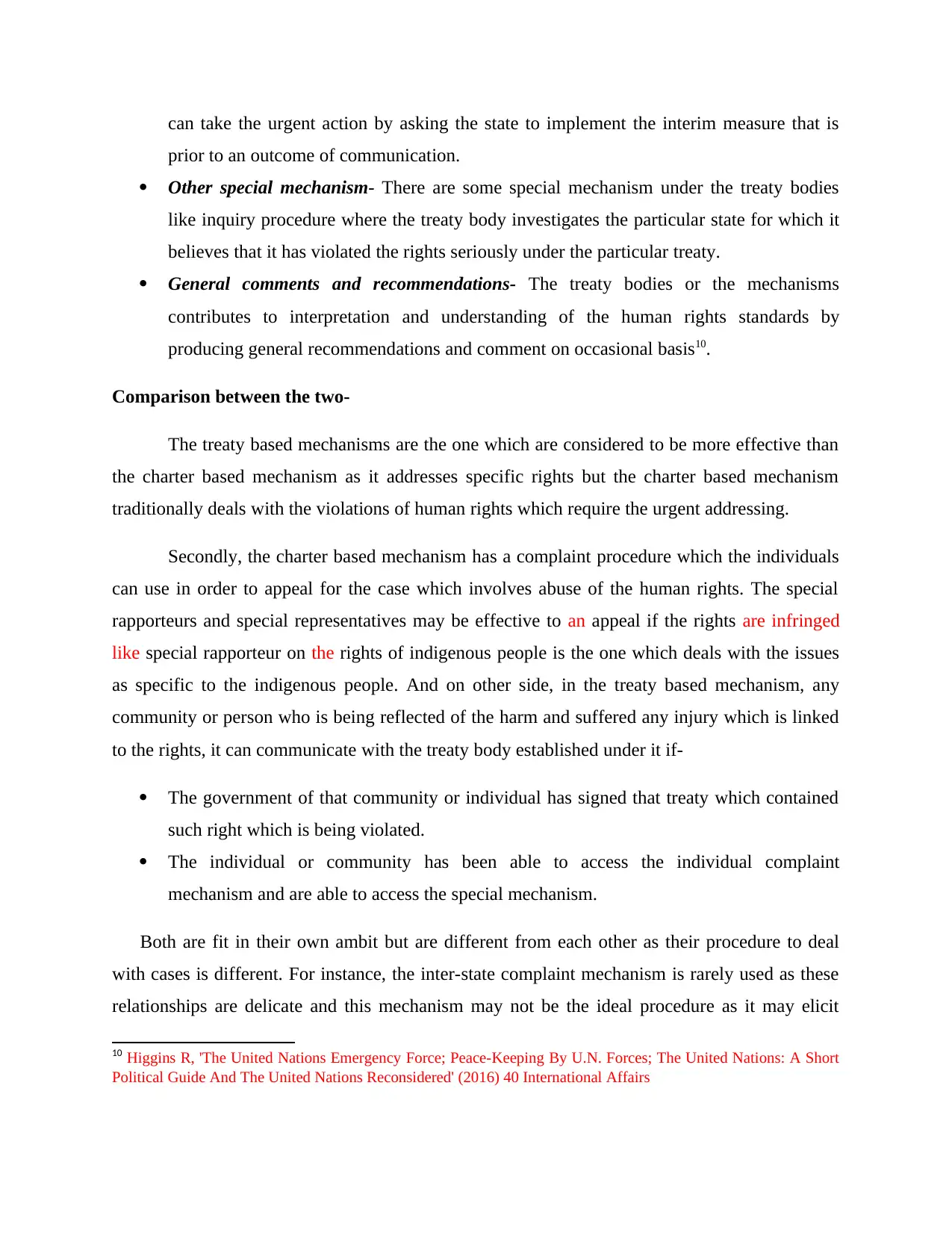
can take the urgent action by asking the state to implement the interim measure that is
prior to an outcome of communication.
Other special mechanism- There are some special mechanism under the treaty bodies
like inquiry procedure where the treaty body investigates the particular state for which it
believes that it has violated the rights seriously under the particular treaty.
General comments and recommendations- The treaty bodies or the mechanisms
contributes to interpretation and understanding of the human rights standards by
producing general recommendations and comment on occasional basis10.
Comparison between the two-
The treaty based mechanisms are the one which are considered to be more effective than
the charter based mechanism as it addresses specific rights but the charter based mechanism
traditionally deals with the violations of human rights which require the urgent addressing.
Secondly, the charter based mechanism has a complaint procedure which the individuals
can use in order to appeal for the case which involves abuse of the human rights. The special
rapporteurs and special representatives may be effective to an appeal if the rights are infringed
like special rapporteur on the rights of indigenous people is the one which deals with the issues
as specific to the indigenous people. And on other side, in the treaty based mechanism, any
community or person who is being reflected of the harm and suffered any injury which is linked
to the rights, it can communicate with the treaty body established under it if-
The government of that community or individual has signed that treaty which contained
such right which is being violated.
The individual or community has been able to access the individual complaint
mechanism and are able to access the special mechanism.
Both are fit in their own ambit but are different from each other as their procedure to deal
with cases is different. For instance, the inter-state complaint mechanism is rarely used as these
relationships are delicate and this mechanism may not be the ideal procedure as it may elicit
10 Higgins R, 'The United Nations Emergency Force; Peace-Keeping By U.N. Forces; The United Nations: A Short
Political Guide And The United Nations Reconsidered' (2016) 40 International Affairs
prior to an outcome of communication.
Other special mechanism- There are some special mechanism under the treaty bodies
like inquiry procedure where the treaty body investigates the particular state for which it
believes that it has violated the rights seriously under the particular treaty.
General comments and recommendations- The treaty bodies or the mechanisms
contributes to interpretation and understanding of the human rights standards by
producing general recommendations and comment on occasional basis10.
Comparison between the two-
The treaty based mechanisms are the one which are considered to be more effective than
the charter based mechanism as it addresses specific rights but the charter based mechanism
traditionally deals with the violations of human rights which require the urgent addressing.
Secondly, the charter based mechanism has a complaint procedure which the individuals
can use in order to appeal for the case which involves abuse of the human rights. The special
rapporteurs and special representatives may be effective to an appeal if the rights are infringed
like special rapporteur on the rights of indigenous people is the one which deals with the issues
as specific to the indigenous people. And on other side, in the treaty based mechanism, any
community or person who is being reflected of the harm and suffered any injury which is linked
to the rights, it can communicate with the treaty body established under it if-
The government of that community or individual has signed that treaty which contained
such right which is being violated.
The individual or community has been able to access the individual complaint
mechanism and are able to access the special mechanism.
Both are fit in their own ambit but are different from each other as their procedure to deal
with cases is different. For instance, the inter-state complaint mechanism is rarely used as these
relationships are delicate and this mechanism may not be the ideal procedure as it may elicit
10 Higgins R, 'The United Nations Emergency Force; Peace-Keeping By U.N. Forces; The United Nations: A Short
Political Guide And The United Nations Reconsidered' (2016) 40 International Affairs
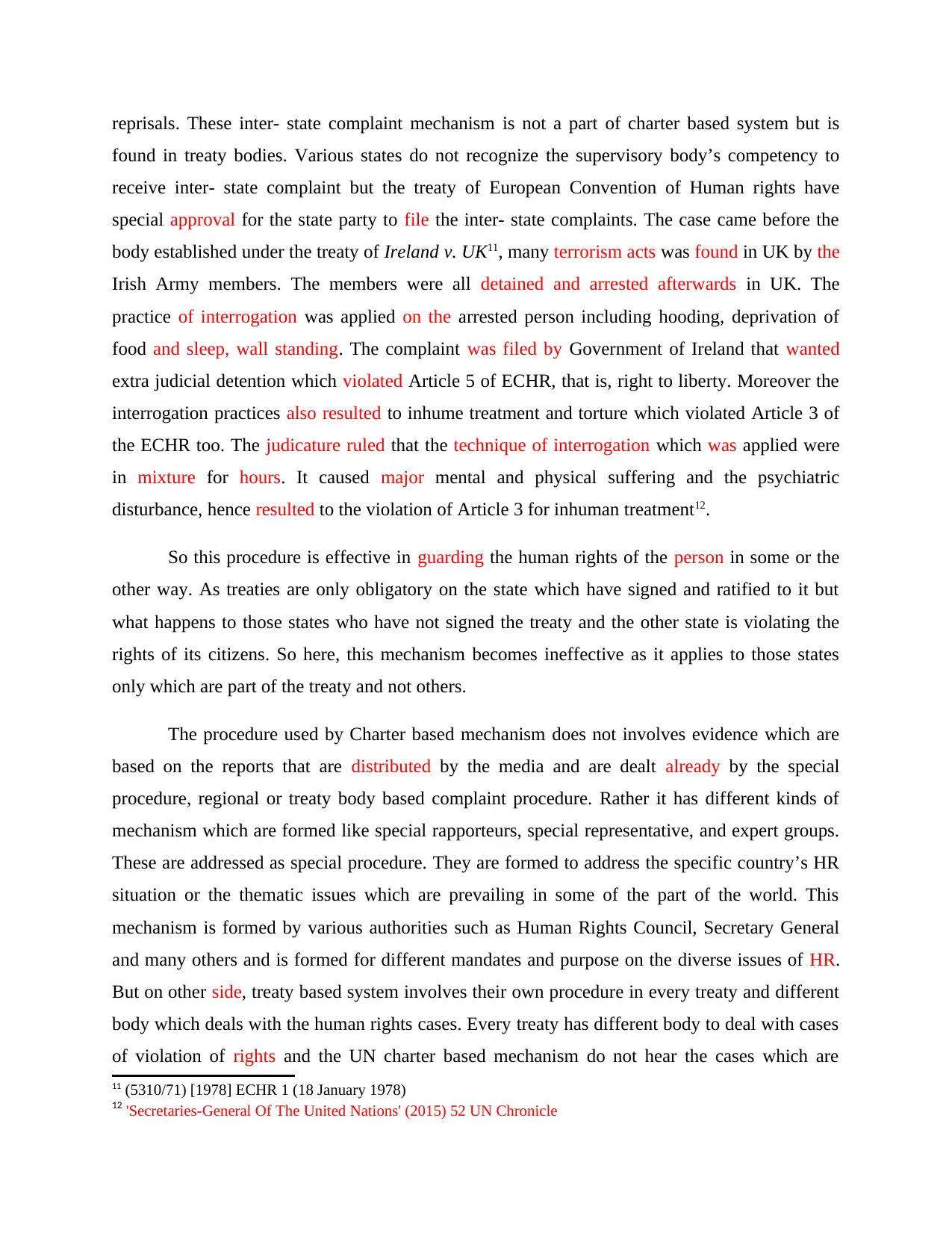
reprisals. These inter- state complaint mechanism is not a part of charter based system but is
found in treaty bodies. Various states do not recognize the supervisory body’s competency to
receive inter- state complaint but the treaty of European Convention of Human rights have
special approval for the state party to file the inter- state complaints. The case came before the
body established under the treaty of Ireland v. UK11, many terrorism acts was found in UK by the
Irish Army members. The members were all detained and arrested afterwards in UK. The
practice of interrogation was applied on the arrested person including hooding, deprivation of
food and sleep, wall standing. The complaint was filed by Government of Ireland that wanted
extra judicial detention which violated Article 5 of ECHR, that is, right to liberty. Moreover the
interrogation practices also resulted to inhume treatment and torture which violated Article 3 of
the ECHR too. The judicature ruled that the technique of interrogation which was applied were
in mixture for hours. It caused major mental and physical suffering and the psychiatric
disturbance, hence resulted to the violation of Article 3 for inhuman treatment12.
So this procedure is effective in guarding the human rights of the person in some or the
other way. As treaties are only obligatory on the state which have signed and ratified to it but
what happens to those states who have not signed the treaty and the other state is violating the
rights of its citizens. So here, this mechanism becomes ineffective as it applies to those states
only which are part of the treaty and not others.
The procedure used by Charter based mechanism does not involves evidence which are
based on the reports that are distributed by the media and are dealt already by the special
procedure, regional or treaty body based complaint procedure. Rather it has different kinds of
mechanism which are formed like special rapporteurs, special representative, and expert groups.
These are addressed as special procedure. They are formed to address the specific country’s HR
situation or the thematic issues which are prevailing in some of the part of the world. This
mechanism is formed by various authorities such as Human Rights Council, Secretary General
and many others and is formed for different mandates and purpose on the diverse issues of HR.
But on other side, treaty based system involves their own procedure in every treaty and different
body which deals with the human rights cases. Every treaty has different body to deal with cases
of violation of rights and the UN charter based mechanism do not hear the cases which are
11 (5310/71) [1978] ECHR 1 (18 January 1978)
12 'Secretaries-General Of The United Nations' (2015) 52 UN Chronicle
found in treaty bodies. Various states do not recognize the supervisory body’s competency to
receive inter- state complaint but the treaty of European Convention of Human rights have
special approval for the state party to file the inter- state complaints. The case came before the
body established under the treaty of Ireland v. UK11, many terrorism acts was found in UK by the
Irish Army members. The members were all detained and arrested afterwards in UK. The
practice of interrogation was applied on the arrested person including hooding, deprivation of
food and sleep, wall standing. The complaint was filed by Government of Ireland that wanted
extra judicial detention which violated Article 5 of ECHR, that is, right to liberty. Moreover the
interrogation practices also resulted to inhume treatment and torture which violated Article 3 of
the ECHR too. The judicature ruled that the technique of interrogation which was applied were
in mixture for hours. It caused major mental and physical suffering and the psychiatric
disturbance, hence resulted to the violation of Article 3 for inhuman treatment12.
So this procedure is effective in guarding the human rights of the person in some or the
other way. As treaties are only obligatory on the state which have signed and ratified to it but
what happens to those states who have not signed the treaty and the other state is violating the
rights of its citizens. So here, this mechanism becomes ineffective as it applies to those states
only which are part of the treaty and not others.
The procedure used by Charter based mechanism does not involves evidence which are
based on the reports that are distributed by the media and are dealt already by the special
procedure, regional or treaty body based complaint procedure. Rather it has different kinds of
mechanism which are formed like special rapporteurs, special representative, and expert groups.
These are addressed as special procedure. They are formed to address the specific country’s HR
situation or the thematic issues which are prevailing in some of the part of the world. This
mechanism is formed by various authorities such as Human Rights Council, Secretary General
and many others and is formed for different mandates and purpose on the diverse issues of HR.
But on other side, treaty based system involves their own procedure in every treaty and different
body which deals with the human rights cases. Every treaty has different body to deal with cases
of violation of rights and the UN charter based mechanism do not hear the cases which are
11 (5310/71) [1978] ECHR 1 (18 January 1978)
12 'Secretaries-General Of The United Nations' (2015) 52 UN Chronicle
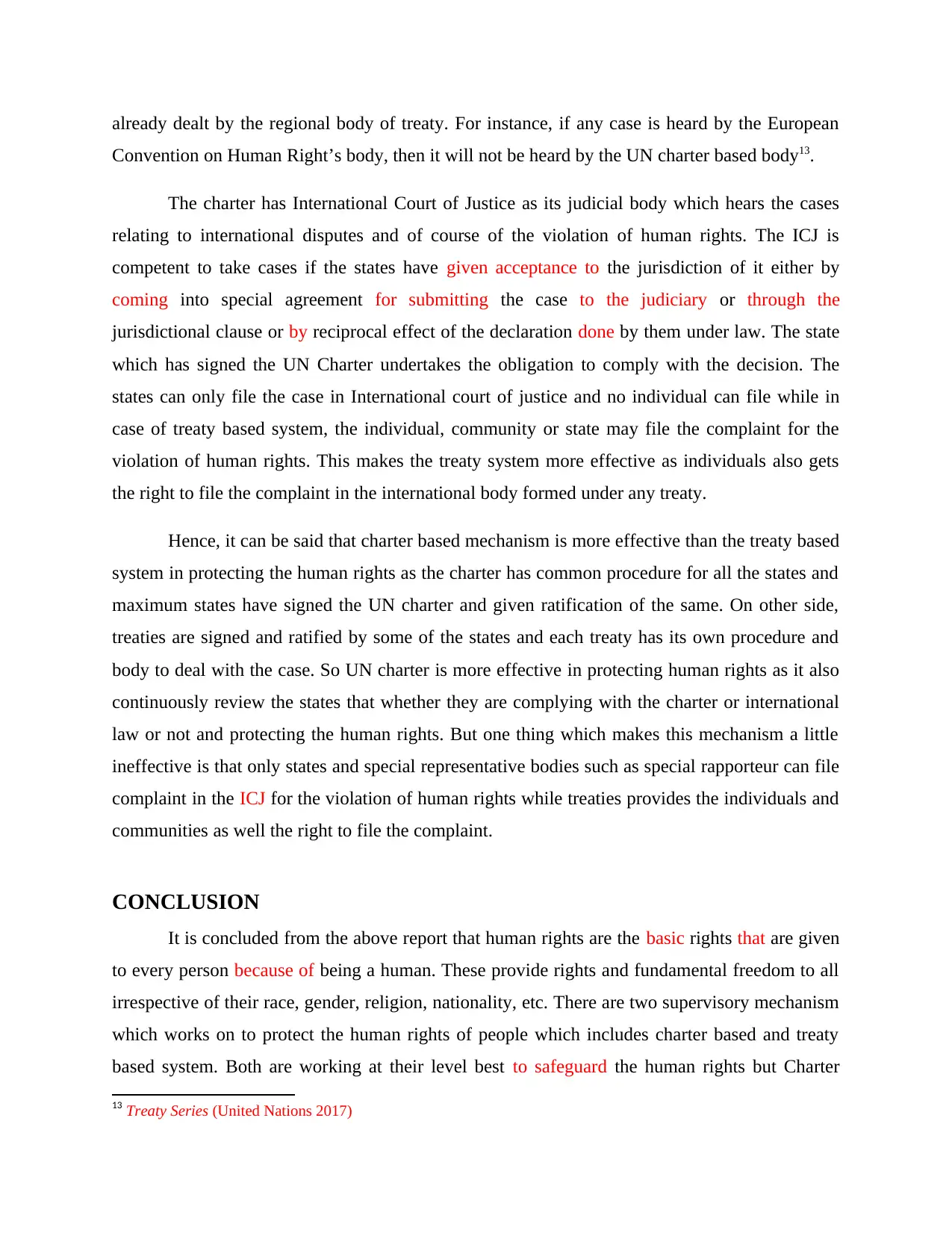
already dealt by the regional body of treaty. For instance, if any case is heard by the European
Convention on Human Right’s body, then it will not be heard by the UN charter based body13.
The charter has International Court of Justice as its judicial body which hears the cases
relating to international disputes and of course of the violation of human rights. The ICJ is
competent to take cases if the states have given acceptance to the jurisdiction of it either by
coming into special agreement for submitting the case to the judiciary or through the
jurisdictional clause or by reciprocal effect of the declaration done by them under law. The state
which has signed the UN Charter undertakes the obligation to comply with the decision. The
states can only file the case in International court of justice and no individual can file while in
case of treaty based system, the individual, community or state may file the complaint for the
violation of human rights. This makes the treaty system more effective as individuals also gets
the right to file the complaint in the international body formed under any treaty.
Hence, it can be said that charter based mechanism is more effective than the treaty based
system in protecting the human rights as the charter has common procedure for all the states and
maximum states have signed the UN charter and given ratification of the same. On other side,
treaties are signed and ratified by some of the states and each treaty has its own procedure and
body to deal with the case. So UN charter is more effective in protecting human rights as it also
continuously review the states that whether they are complying with the charter or international
law or not and protecting the human rights. But one thing which makes this mechanism a little
ineffective is that only states and special representative bodies such as special rapporteur can file
complaint in the ICJ for the violation of human rights while treaties provides the individuals and
communities as well the right to file the complaint.
CONCLUSION
It is concluded from the above report that human rights are the basic rights that are given
to every person because of being a human. These provide rights and fundamental freedom to all
irrespective of their race, gender, religion, nationality, etc. There are two supervisory mechanism
which works on to protect the human rights of people which includes charter based and treaty
based system. Both are working at their level best to safeguard the human rights but Charter
13 Treaty Series (United Nations 2017)
Convention on Human Right’s body, then it will not be heard by the UN charter based body13.
The charter has International Court of Justice as its judicial body which hears the cases
relating to international disputes and of course of the violation of human rights. The ICJ is
competent to take cases if the states have given acceptance to the jurisdiction of it either by
coming into special agreement for submitting the case to the judiciary or through the
jurisdictional clause or by reciprocal effect of the declaration done by them under law. The state
which has signed the UN Charter undertakes the obligation to comply with the decision. The
states can only file the case in International court of justice and no individual can file while in
case of treaty based system, the individual, community or state may file the complaint for the
violation of human rights. This makes the treaty system more effective as individuals also gets
the right to file the complaint in the international body formed under any treaty.
Hence, it can be said that charter based mechanism is more effective than the treaty based
system in protecting the human rights as the charter has common procedure for all the states and
maximum states have signed the UN charter and given ratification of the same. On other side,
treaties are signed and ratified by some of the states and each treaty has its own procedure and
body to deal with the case. So UN charter is more effective in protecting human rights as it also
continuously review the states that whether they are complying with the charter or international
law or not and protecting the human rights. But one thing which makes this mechanism a little
ineffective is that only states and special representative bodies such as special rapporteur can file
complaint in the ICJ for the violation of human rights while treaties provides the individuals and
communities as well the right to file the complaint.
CONCLUSION
It is concluded from the above report that human rights are the basic rights that are given
to every person because of being a human. These provide rights and fundamental freedom to all
irrespective of their race, gender, religion, nationality, etc. There are two supervisory mechanism
which works on to protect the human rights of people which includes charter based and treaty
based system. Both are working at their level best to safeguard the human rights but Charter
13 Treaty Series (United Nations 2017)
Secure Best Marks with AI Grader
Need help grading? Try our AI Grader for instant feedback on your assignments.

based mechanism is more effective as compared to treaty as the former covers every state while
treaty covers those who have signed the treaty.
treaty covers those who have signed the treaty.
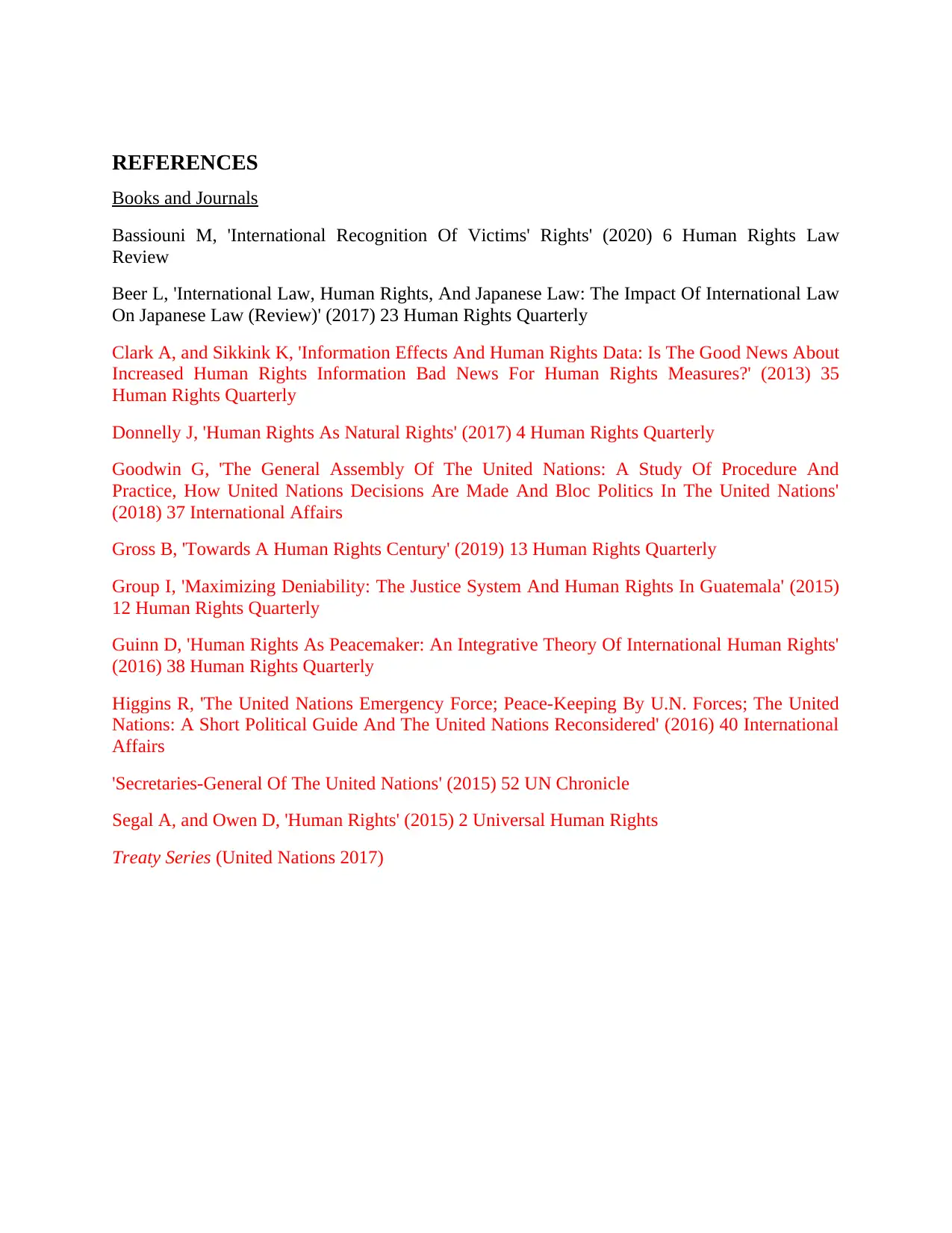
REFERENCES
Books and Journals
Bassiouni M, 'International Recognition Of Victims' Rights' (2020) 6 Human Rights Law
Review
Beer L, 'International Law, Human Rights, And Japanese Law: The Impact Of International Law
On Japanese Law (Review)' (2017) 23 Human Rights Quarterly
Clark A, and Sikkink K, 'Information Effects And Human Rights Data: Is The Good News About
Increased Human Rights Information Bad News For Human Rights Measures?' (2013) 35
Human Rights Quarterly
Donnelly J, 'Human Rights As Natural Rights' (2017) 4 Human Rights Quarterly
Goodwin G, 'The General Assembly Of The United Nations: A Study Of Procedure And
Practice, How United Nations Decisions Are Made And Bloc Politics In The United Nations'
(2018) 37 International Affairs
Gross B, 'Towards A Human Rights Century' (2019) 13 Human Rights Quarterly
Group I, 'Maximizing Deniability: The Justice System And Human Rights In Guatemala' (2015)
12 Human Rights Quarterly
Guinn D, 'Human Rights As Peacemaker: An Integrative Theory Of International Human Rights'
(2016) 38 Human Rights Quarterly
Higgins R, 'The United Nations Emergency Force; Peace-Keeping By U.N. Forces; The United
Nations: A Short Political Guide And The United Nations Reconsidered' (2016) 40 International
Affairs
'Secretaries-General Of The United Nations' (2015) 52 UN Chronicle
Segal A, and Owen D, 'Human Rights' (2015) 2 Universal Human Rights
Treaty Series (United Nations 2017)
Books and Journals
Bassiouni M, 'International Recognition Of Victims' Rights' (2020) 6 Human Rights Law
Review
Beer L, 'International Law, Human Rights, And Japanese Law: The Impact Of International Law
On Japanese Law (Review)' (2017) 23 Human Rights Quarterly
Clark A, and Sikkink K, 'Information Effects And Human Rights Data: Is The Good News About
Increased Human Rights Information Bad News For Human Rights Measures?' (2013) 35
Human Rights Quarterly
Donnelly J, 'Human Rights As Natural Rights' (2017) 4 Human Rights Quarterly
Goodwin G, 'The General Assembly Of The United Nations: A Study Of Procedure And
Practice, How United Nations Decisions Are Made And Bloc Politics In The United Nations'
(2018) 37 International Affairs
Gross B, 'Towards A Human Rights Century' (2019) 13 Human Rights Quarterly
Group I, 'Maximizing Deniability: The Justice System And Human Rights In Guatemala' (2015)
12 Human Rights Quarterly
Guinn D, 'Human Rights As Peacemaker: An Integrative Theory Of International Human Rights'
(2016) 38 Human Rights Quarterly
Higgins R, 'The United Nations Emergency Force; Peace-Keeping By U.N. Forces; The United
Nations: A Short Political Guide And The United Nations Reconsidered' (2016) 40 International
Affairs
'Secretaries-General Of The United Nations' (2015) 52 UN Chronicle
Segal A, and Owen D, 'Human Rights' (2015) 2 Universal Human Rights
Treaty Series (United Nations 2017)
1 out of 12
Related Documents
Your All-in-One AI-Powered Toolkit for Academic Success.
+13062052269
info@desklib.com
Available 24*7 on WhatsApp / Email
![[object Object]](/_next/static/media/star-bottom.7253800d.svg)
Unlock your academic potential
© 2024 | Zucol Services PVT LTD | All rights reserved.





